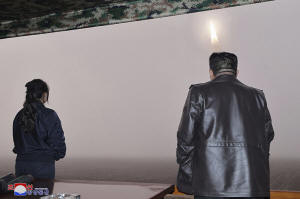North Korea boasts of 'the world's strongest' missile, but experts say
it's too big to use in war
 Send a link to a friend
Send a link to a friend
 [November 01, 2024]
By HYUNG-JIN KIM and KIM TONG-HYUNG [November 01, 2024]
By HYUNG-JIN KIM and KIM TONG-HYUNG
SEOUL, South Korea (AP) — North Korea boasted Friday that the new
intercontinental ballistic missile it just test-launched is “the world’s
strongest,” a claim seen as pure propaganda after experts assessed it as
being too big to be useful in a war situation.
The ICBM launched Thursday flew higher and for a longer duration than
any other weapon North Korea has tested. But foreign experts say the
test failed to show North Korea has mastered some of the last remaining
technological hurdles to possess functioning ICBMs that can strike the
mainland U.S.
The North’s Korean Central News Agency identified the missile as a
Hwasong-19 and called it “the world’s strongest strategic missile” and
“the perfected weapon system.” The official media outlet said leader Kim
Jong Un observed the launch, describing it as an expression of North
Korea’s resolve to respond to external threats to North Korea’s
security.
The color and shape of the exhaust flames seen in North Korean media
photos of the launch suggest the missile uses preloaded solid fuel,
which makes weapons more agile and harder to detect than liquid
propellants that in general must be fueled beforehand.
But experts say the photos show the ICBM and its launch vehicle are both
oversized, raising a serious question about their wartime mobility and
survivability.
“When missiles get bigger, what happens? The vehicles get larger, too.
As the transporter-erector launchers get bigger, their mobility
decreases,” Lee Sangmin, an expert at South Korea’s Korea Institute for
Defense Analyses.

The Hwasong-19 was estimated to be at least 28 meters long (92 feet)
while advanced U.S. and Russian ICBMs are less than 20 meters long (66
feet), said Chang Young-keun, a missile expert at Seoul’s Korea Research
Institute for National Strategy. He suggested that the missile's size
likely helped South Korean intelligence authorities detect the launch
plan in advance.
“In the event of a conflict, such an exposure makes the weapon a target
of a preemptive attack by opponents so there would be a big issue of
survivability,” Chang said.
Lee Illwoo, an expert with the Korea Defense Network in South Korea,
said North Korea may have developed a larger missile to carry bigger and
more destructive warheads or multi-warheads. If that's the case, Lee
said North Korea could have used liquid fuels as they generate higher
thrust than solid fuels. He said some advanced liquid propellants can be
stored in missiles for a few weeks before liftoffs.
Lee said North Korea may have placed a dummy, empty warhead on the
Hwasong-19 to make it fly higher.
In recent years, North Korea has reported steady advancement in its
efforts to obtain nuclear-tipped missiles. Many foreign experts believe
North Korea likely has missiles that can deliver nuclear strikes on all
of South Korea, but it has yet to possess nuclear missiles that can
strike the mainland U.S.
The hurdles it has yet to overcome, according to experts, include
ensuring its warheads survive the heat and stress of atmospheric
reentry, improving the altitude control and guidance systems for the
missiles, and being able to use multiple warheads on a single missile to
defeat missile defenses.
“Acquiring reentry technology is currently the most important goal in
North Korea’s missile development, specifically for ICBMs, but they just
keep increasing the ranges instead. This possibly suggests they still
lack confidence in their reentry technology,” Lee Sangmin said.
[to top of second column]
|

In this photo provided by the North Korean government, North Korean
leader Kim Jong Un, right, and his daughter observe what it says a
test launch of new intercontinental ballistic missile "Hwasong-19"
at an undisclosed place in North Korea Thursday, Oct. 31, 2024.
Independent journalists were not given access to cover the event
depicted in this image distributed by the North Korean government.
The content of this image is as provided and cannot be independently
verified. Korean language watermark on image as provided by source
reads: "KCNA" which is the abbreviation for Korean Central News
Agency. (Korean Central News Agency/Korea News Service via AP)

Chang said Friday's state media dispatch on the launch lacks details on
the technological aspects of the Hawsong-19 and focused on publicity.
Other North Korean claims about its weapons capabilities have been met
with wide outside skepticism.
In June, North Korea claimed to have tested a multiwarhead missile in
the first known launch of such a weapon, but South Korea said the weapon
instead blew up. In July, when North Korea said it had test-fired a new
tactical ballistic missile capable of carrying “a super-large warhead,”
South Korea said the claim was an attempt to conceal a botched launch.
North Korea's missile program is still a major regional security
concern, with the country openly threatening to use its nuclear missiles
against its rivals. In a joint statement Thursday, the foreign ministers
of South Korea, the U.S. and Japan condemned the ICBM launch as a
violation of U.N. Security Council resolutions and said they're
committed to strengthening their efforts to block North Korea's illicit
revenue generation funding its missile and nuclear programs.
South Korea's Foreign Ministry said Friday it has imposed unilateral
sanctions on 11 North Korean individuals and four organizations for
their alleged roles in procuring missile components and generating
foreign currency to fund Pyongyang’s weapons program. The sanctions are
largely symbolic given that financial transactions between the Koreas
have been suspended for years.
Also Friday, South Korea and the U.S. conducted their first-ever joint
live-fire exercise using unmanned aerial vehicles as part of efforts to
demonstrate their readiness. South Korea’s RQ-4B “Global Hawk”
reconnaissance aircraft and the U.S. MQ-9 Reaper strike drone were
mobilized for the training, according to South Korea's air force. South
Korea and the U.S. have been expanding their regular military drills to
cope with North Korea’s evolving nuclear threats.
Observers say that Thursday's launch, the North's first ICBM test in
almost a year, was largely meant to grab American attention days before
the U.S. presidential election and respond to international condemnation
over North Korea's reported dispatch of troops to Russia to support its
war against Ukraine.
North Korea's reported troop dispatch highlights the expanding military
cooperation between North Korea and Russia. South Korea. the U.S. and
others worry North Korea might seek high-tech, sensitive Russian
technology to perfect its nuclear and missile programs in return for
joining the Russian-Ukraine war.
All contents © copyright 2024 Associated Press. All rights reserved
 |